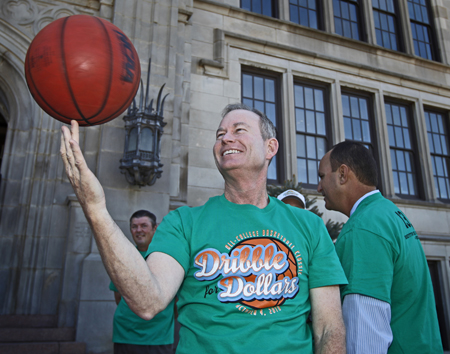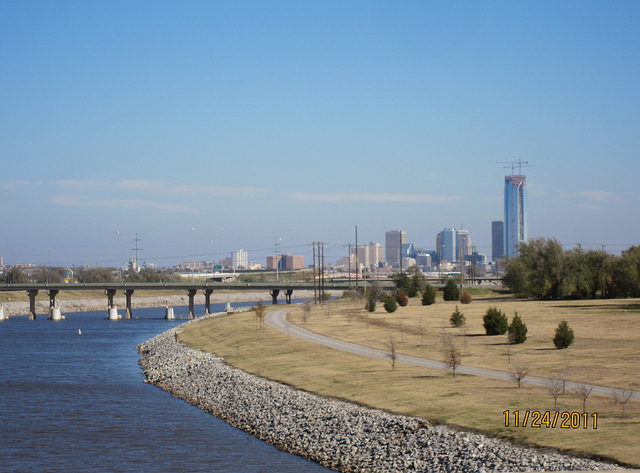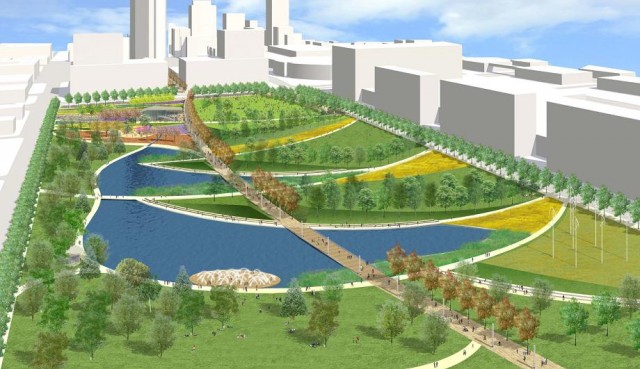Oklahoma City Mayor Mick Cornett: We Have to Build This City For People
3:56 PM EST on January 24, 2013

On the last day of 2007, Mick Cornett, the Republican mayor of Oklahoma City -- ranked as one of the fattest cities in the country -- stood in front of the elephants at the zoo and announced he was going on a diet, and taking the rest of the city with him. Oklahoma City lost a million pounds, 37 of which were his.
Cornett's zeal to make Oklahoma City a healthier city led him to take a hard look at the built environment. He realized that car-centric, pedestrian-unfriendly streets weren't just costing residents their health, they were costing brainpower -- too many of Oklahoma City's talented young people were leaving. Businesses didn't want to locate there because their employees didn't want to live there.
So Mayor Cornett sought -- and got -- public support for a $777 million package of investments to construct a new downtown park and recreation areas by the riverfront, build out the streetcar system, expand sidewalks and biking trails, and create new senior wellness centers. Another $180 million was raised to redesign downtown streets. If Oklahoma City is a different place now than it was 10 years ago, residents have the mayor to thank.
I caught up with Cornett at the annual meeting of the United States Conference of Mayors last week in Washington, DC, right after he spoke at a luncheon panel -- sponsored by Weight Watchers -- about what mayors can do when they inherit a city "zoned as a series of drive-thru restaurants."
Tanya Snyder: Oklahoma City isn’t New York City. It doesn’t have that kind of density. With pedestrian-friendliness, there are things like crosswalks and sidewalks that you can do but you also have to have places to walk and make sure the distances between destinations are reasonable distances. How do you address that in a city, like Oklahoma City, that is spread out?
Mayor Mick Cornett: The first thing you have to do is change the perspective. The way I describe it is: We have built this city for cars. We have to start building this city for people.
When that message percolates inside City Hall, inside your public works department and inside your planning department, they start to look at things differently. And what I noticed was, it wasn’t a lack of enlightenment. It was a lack of direction. They were doing what they felt like they were supposed to be doing. And when we exposed this new direction, I was amazed how much creativity was inside those departments that I hadn’t seen before, that hadn’t been tapped. It was as if they’d been unleashed -- all these new ideas.
There was also an increase in green spaces. We didn’t have sidewalks in a lot of communities and so we’re going back in and building, literally, hundreds of miles of sidewalks throughout the city. It’s a lot better to do it on the front end and not go back in later and put those in. It’s more expensive to do it the way we’re doing it. But it is what it is.
We’re completing our bicycle trail master plan. We were using some federal money every year that came in to extend our bike trail plan. One day I asked the parks director in a public meeting, I said, “At the rate we’re going, when are we going to finish our master plan?” And he was speechless. And what I realized was, we were all going to be long gone by the time we finished our master plan.
So in this large initiative that I pushed three years ago that included a lot of these funding elements, we just finished the bicycle trail master plan all in one fell swoop. So we’ll have over a hundred miles total, when we’re done completing it, throughout the city. It connects all of our lakes and rivers and all of those things.
The other way I’d describe it is that in our city, we had placed higher standards on what we did -- we were building bridges with higher standards, our streets had higher standards, our buildings were winning architectural awards – we had placed higher standards on everything except us. We were allowing ourselves to be more and more obese and less healthy. When I looked at it freshly I thought, “No wonder we’re not healthy – we’ve designed this city so you never have to walk anywhere.”
In fact, we’ve designed this city so you can’t walk anywhere! That’s not easy to change, but you can certainly start, and it’s happening much more quickly than I would have ever guessed that it could. People really like the new direction. And we’re now building neighborhoods where you don’t have to own a car if you don’t want to. You can live, work and play all in the same neighborhood -- and that was unheard of ten years ago.
TS: You’ve also pushed for federal funding for Transportation Enhancements. I’m curious about what your conversations are like with your secretary of transportation and your senators about this. Do they understand that when they say, "We don’t want federal money going to these things," that one of their major cities -- that they’re supposedly speaking for -- really does want it? And as a follow-up to that, are you satisfied with the compromise that came out in MAP-21 for Transportation Alternatives?
MC: I don’t think there was enough money in all the transportation efforts. Of our two senators, Sen. Coburn is a fiscal hawk. It’s hard to predict what he’s going to vote for, and I don’t pretend to have any influence over him.
Sen. Inhofe, although he’s a very conservative Republican, he’s strong on transportation and infrastructure, and I’ll note he was a former mayor. I don’t think that’s a coincidence. He was the mayor of Tulsa. So a large city mayor gets into Washington and is largely against spending but not for infrastructure! He’s there for us -- generally.

TS: But not for sidewalks and bike trails.
MC: Yeah, that was an extension he didn’t see fit. But nonetheless if we get money for [infrastructure] we can use other money for [bike/ped]. If we can just get more money for infrastructure we’d be better off.
I don’t have a major problem with a senator philosophically feeling like bicycle trails and sidewalks should be funded at the local level. I might feel the same way if I were [in Washington]. But I know on the receiving end, we value those dollars greatly. There’s so much we can do with those dollars, and they’re so appreciated. In our city, we have 17,000 lane miles of road that we’re responsible for. That’s a lot more than the federal government’s responsible for.
But I understand their point of view. They want [federal funding] to be more about things that move commerce -- okay. And in our city we’re funding those sidewalks and trails locally. We’re doing it, regardless of their help.
I would love to have the discretion that the bill would have put in, to allow us to have a few percentage points for it, and we would have used it. That would have been great and I did push them to put that in. But it’s not crazy for those that are trying to cut the budget to think that that ought to be funded at the local level.
I’ll tell you what’s happening though -- and this is what I fear for American cities -- is that there’s been so much federal funding coming in years past that it’s almost been an equalizer for cities.
Oklahoma City is proactively funding infrastructure projects. But most cities aren’t. And I’m thinking, if the federal money dries up and it has to come locally, you’re going to develop cities of haves and have-nots. Cities are going to have winners and losers. Oklahoma City is set up to succeed in that scenario, but it’s not good for the American city.
In a lot of communities, the enabling legislation to proactively support your own infrastructure needs is not there. Louisville right now, they can’t have a sales tax election to fund local stuff like we do. And so if the federal government’s not going to fund it, you’ve really tied their hands on how they’re going to fund it. It’s really hard for them to go out and get their citizens to go out and increase their taxes for something, even if they like it.
TS: Have you had any pushback on that with your MAPS program? I know you’re very specific about what the projects are going to be, and everybody says when you’re doing a sales tax or something like that that the more specific you can be about what they’re going to get for it, the better your chance of success. Has there ever been a project that you’ve put forward and people said, “No, we don’t want to pay for that one”?
MC: Passed ‘em all. But they’re not easy to pass. We have a very active anti-tax environment in Oklahoma City. So it’s something short of a miracle that we’ve been able to pass this series of initiatives and we’ve never lost one. And the last time, we had a funded opponent -- our police and fire unions opposed it.
That was the most difficult thing I’ve ever been through, emotionally and intellectually, to try to win that. But we won it.
TS: They were worried about the streets being too narrow?
MC: No. There wasn’t anything in it for them. In most cities you go get public safety unions’ permission to run sales tax amendments. I didn’t ask for permission. So they funded a campaign to oppose it.
TS: That’s too bad.
MC: Yeah. I’m glad we won.
Check back tomorrow for Part Two of our interview, where we talk about Agenda 21, congestion-free cities, and why suburbanites should (and now do) care about the inner city.
Stay in touch
Sign up for our free newsletter
More from Streetsblog USA
Thursday’s Headlines Are Down on Highways
Two outlets recently featured articles on the harmful effects of ongoing freeway projects.
Talking Headways Podcast: Details of Development Reform in Minnesota, Part I
Jim Kumon of Electric Housing discusses his work as a developer and urban policy educator in the Twin Cities.
Thursday’s Headlines Don’t Like Riding on the Passenger Side
Can you take me to the store, and then the bank? I've got five dollars you can put in the tank.
Study: When Speed Limits Rise on Interstates, So Do Crash Hot Spots on Nearby Roads
Rising interstate speeds don't just make roads deadlier for people who drive on them — and local decision makers need to be prepared.
Calif. Bill to Require Speed Control in Vehicles Goes Limp
Also passed yesterday were S.B 961, the Complete Streets bill, a bill on Bay Area transit funding, and a prohibition on state funding for Class III bikeways.





